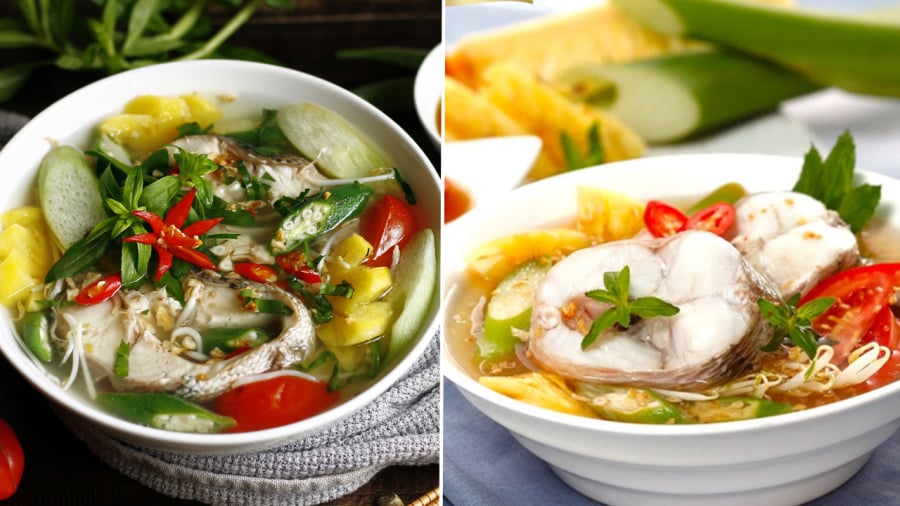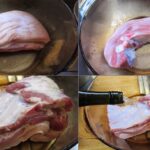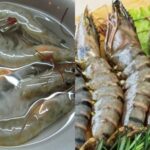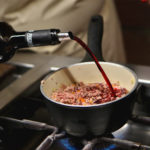What Ingredients Can Be Used to Make a Sweet and Non-Fishy Fish Broth?
- Ingredients with a Sour Taste
For ages, cooks have used ingredients with a sour taste (containing organic acids) to neutralize the alkaline trimethylamine that causes fishiness.
In Northern Vietnam, it is common to cook fish broth with sour ingredients such as qua doc, qua queo, thanh trai, tai chua, qua chay, me, giams bong, and dua chua.
In the South, they often use me (a type of tamarind) or pineapple to achieve the same effect.
Additionally, cooks often add tomatoes to fish broth. Tomatoes provide a gentle sourness and also enhance the color of the broth.
The sour ingredients help to create a more harmonious flavor profile and better stimulate the palate.

Sour ingredients can be used to reduce the fishy taste in fish broth.
- Ingredients with an Astringent Taste
Astringent ingredients like unripe bananas and banana flowers contain tannins, which can effectively mask the fishy taste. Dishes like fish broth cooked with unripe bananas and chanchies (a type of goby) cooked with banana flowers are famous in Thai Binh province for their rustic and appealing flavor, free from any fishiness.
- Adding Cooking Wine
Restaurant chefs often use cooking wine in fish dishes to eliminate the fishy smell. The alcohol in the wine can dissolve and remove trimethylamine, the compound responsible for the fishy odor.
A small amount of cooking wine or clear liquor can be added during the initial preparation and cooking stages to neutralize any fishy aroma.
- Using Aromatic Herbs
The choice of aromatic herbs depends on the style of fish broth being prepared. For most fish broths in Northern Vietnam, dill is an indispensable ingredient. In some regions of Thai Binh, people add la lot (betel leaves) to their fish broth.
For the Canh Chua (sour soup) of the South, they typically use rice paddy herb, culantro, and chili peppers.
Aromatic herbs are usually added to the broth just before serving. After ladling the hot broth into bowls, the herbs are placed on top to retain their fragrance and avoid wilting, ensuring the dish looks appealing.
Other Tips for Cooking Fish Broth

Pay attention to these cooking tips to avoid a fishy-tasting fish broth.
To ensure your fish broth doesn’t taste fishy, keep in mind the following:
- Fish Preparation
Before cooking, thoroughly clean the fish. Remove the guts, fins, and scales, and carefully scrape away the black membrane inside the belly. Rinse the fish with rice washing water, salt, lemon juice, vinegar, liquor, or ginger to effectively eliminate any fishy smell.
- Fry the Fish Before Cooking
Depending on the recipe, you may choose to fry the fish before cooking it in broth. Frying helps firm up the fish, preventing it from breaking apart during cooking. It also locks in the fishy taste, resulting in a less pungent broth. However, this method adds more oil to the dish. Frying is commonly applied to freshwater fish like carp and rohu in Northern Vietnamese cuisine. Feel free to adapt this technique according to your preferences.
- Use Hot Water
An essential tip for cooking fish broth is to always use hot water. Hot water cooks the fish skin quickly, preventing the dissolution of amino acids, which reduces the fishy taste. Additionally, hot water helps retain more nutrients in the fish meat.
“Boil Chicken in Plain Water? Try This Instead for Tender, Flavorful Meat”
With just a few easily accessible spices, such as onions and ginger, you can create a mouth-watering boiled chicken dish that will have your taste buds doing a happy dance. This simple yet flavorful dish is a testament to the power of a few well-chosen ingredients, transforming the ordinary into something truly extraordinary.
The Perfect Boiled Shrimp: A Delicate, Sweet, and Savory Delight
“Steamed shrimp is a delicious and nutritious dish that can be enjoyed as a refreshing treat. However, not everyone knows the secret to preparing it in a way that eliminates any unwanted fishy taste. With the right techniques and ingredients, you can transform this seafood delight into a mouth-watering sensation that will leave your taste buds craving for more. Imagine serving up a plate of tender, juicy shrimp that tastes absolutely divine – it’s an art that can be mastered with the right guidance.”
What is Cooking Wine? Its Uses and How to Use It
Introducing the world of culinary delights and the secret ingredient that elevates your dishes – cooking wine! Have you ever wondered about the mysterious liquid that often appears in recipes? Well, it’s time to uncover the magic behind this cooking staple and explore how it differs from your average tipple. Join us on a journey as we delve into the heart of the kitchen, discovering the wonders of cooking wine, its uses, and the magic it brings to your culinary creations.



































